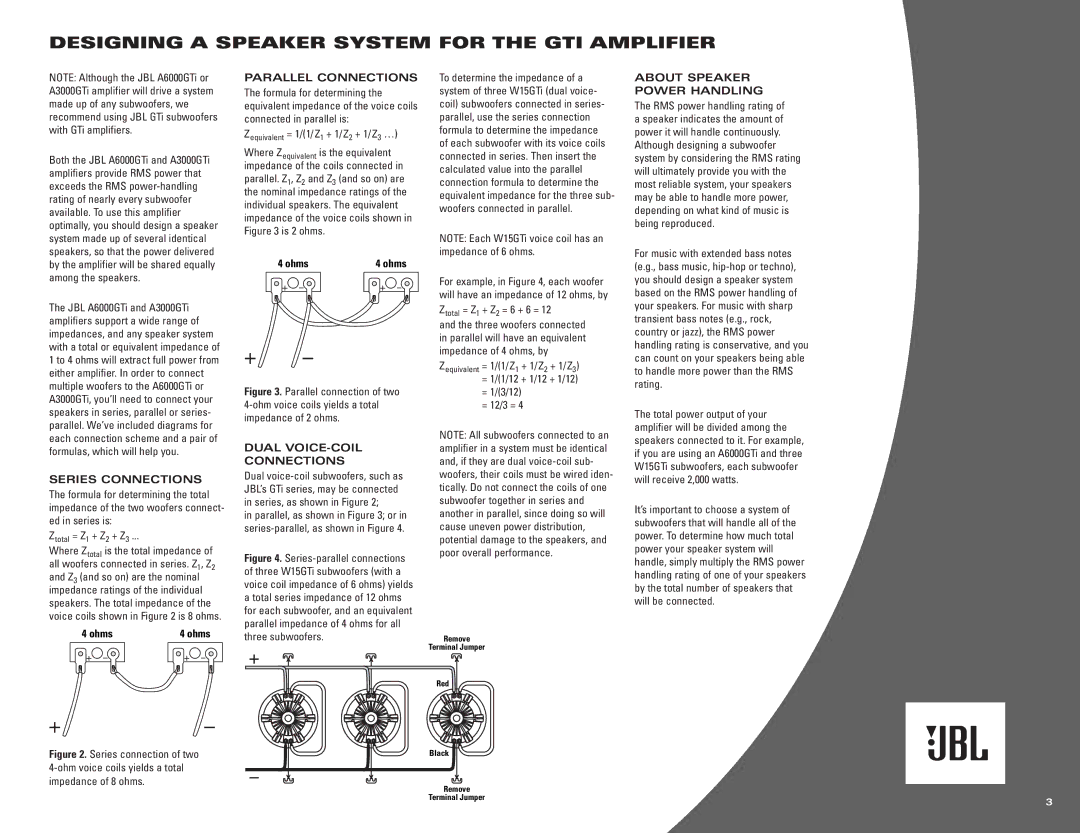
DESIGNING A SPEAKER SYSTEM FOR THE GTI AMPLIFIER
NOTE: Although the JBL A6000GTi or A3000GTi amplifier will drive a system made up of any subwoofers, we recommend using JBL GTi subwoofers with GTi amplifiers.
Both the JBL A6000GTi and A3000GTi amplifiers provide RMS power that exceeds the RMS
The JBL A6000GTi and A3000GTi amplifiers support a wide range of impedances, and any speaker system with a total or equivalent impedance of 1 to 4 ohms will extract full power from either amplifier. In order to connect multiple woofers to the A6000GTi or A3000GTi, you’ll need to connect your speakers in series, parallel or series- parallel. We’ve included diagrams for each connection scheme and a pair of formulas, which will help you.
SERIES CONNECTIONS
The formula for determining the total impedance of the two woofers connect- ed in series is:
Ztotal = Z1 + Z2 + Z3 ...
Where Ztotal is the total impedance of all woofers connected in series. Z1, Z2
and Z3 (and so on) are the nominal impedance ratings of the individual speakers. The total impedance of the voice coils shown in Figure 2 is 8 ohms.
4 ohms |
| 4 ohms | ||||||||||||
|
|
|
|
|
|
|
|
|
|
|
|
|
|
|
Figure 2. Series connection of two 4-ohm voice coils yields a total impedance of 8 ohms.
PARALLEL CONNECTIONS
The formula for determining the equivalent impedance of the voice coils connected in parallel is:
Zequivalent = 1/(1/Z1 + 1/Z2 + 1/Z3 …)
Where Zequivalent is the equivalent impedance of the coils connected in
parallel. Z1, Z2 and Z3 (and so on) are the nominal impedance ratings of the individual speakers. The equivalent impedance of the voice coils shown in Figure 3 is 2 ohms.
4 ohms |
| 4 ohms | ||||||||||||
|
|
|
|
|
|
|
|
|
|
|
|
|
|
|
Figure 3. Parallel connection of two 4-ohm voice coils yields a total impedance of 2 ohms.
DUAL VOICE-COIL
CONNECTIONS
Dual
in parallel, as shown in Figure 3; or in
Figure 4. Series-parallel connections of three W15GTi subwoofers (with a voice coil impedance of 6 ohms) yields a total series impedance of 12 ohms for each subwoofer, and an equivalent parallel impedance of 4 ohms for all three subwoofers.
To determine the impedance of a system of three W15GTi (dual voice- coil) subwoofers connected in series- parallel, use the series connection formula to determine the impedance of each subwoofer with its voice coils connected in series. Then insert the calculated value into the parallel connection formula to determine the equivalent impedance for the three sub- woofers connected in parallel.
NOTE: Each W15GTi voice coil has an impedance of 6 ohms.
For example, in Figure 4, each woofer will have an impedance of 12 ohms, by
Ztotal = Z1 + Z2 = 6 + 6 = 12
and the three woofers connected in parallel will have an equivalent impedance of 4 ohms, by
Zequivalent = 1/(1/Z1 + 1/Z2 + 1/Z3)
=1/(1/12 + 1/12 + 1/12)
=1/(3/12)
=12/3 = 4
NOTE: All subwoofers connected to an amplifier in a system must be identical and, if they are dual
Remove
Terminal Jumper
Red
Black
ABOUT SPEAKER
POWER HANDLING
The RMS power handling rating of a speaker indicates the amount of power it will handle continuously. Although designing a subwoofer system by considering the RMS rating will ultimately provide you with the most reliable system, your speakers may be able to handle more power, depending on what kind of music is being reproduced.
For music with extended bass notes (e.g., bass music,
The total power output of your amplifier will be divided among the speakers connected to it. For example, if you are using an A6000GTi and three W15GTi subwoofers, each subwoofer will receive 2,000 watts.
It’s important to choose a system of subwoofers that will handle all of the power. To determine how much total power your speaker system will handle, simply multiply the RMS power handling rating of one of your speakers by the total number of speakers that will be connected.
Remove
Terminal Jumper
3
